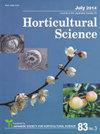Hairy Vetch Derived-N Uptake by Tomato Grown in a Pot Containing Fast- and Slow-release N Fertilizer
Journal of The Japanese Society for Horticultural Science
Pub Date : 2014-04-23
DOI:10.2503/JJSHS1.CH-061
引用次数: 3
Abstract
In order to improve the use efficiency of a cover crop, hairy vetch (Vicia villosa R., HV), and supplemental chemical N fertilizer, N release and uptake patterns from HV, fast-release N fertilizer (Fast), and slow-release N fertilizer (Slow) in fresh market tomato (Solanum lycopersicum L.) production were investigated using the 15N-labeling method. In the incubation of soil-added N at two mix rates, 20% Fast + 80% Slow (FS) and 100% Slow (S), a large amount of inorganic N, mainly NH4-N, was released by FS in 4 weeks. Tomato ‘House momotaro’ was grown in 1/2000 a Wagner pots incorporating such N fertilizer and 15N-labeled HV residue (30 g DW/pot, about 200 kg N·ha-1). Plant biomass in tomato grown with HV was larger than that grown without HV. HV-derived N (Ndfhv) was taken up by the tomatoes mainly until 4 weeks after transplant (WAT). The uptake amount of Ndfhv was the same in the pot with HV-FS and HV-S. The rate of N uptake derived from HV to total N uptake in tomato plants (%Ndfhv) was 43% in HV-S, higher than that in HV-FS (34%) in 4 WAT; however, such a difference disappeared after 4 WAT. N uptake by tomato plants continued until 12 WAT. Based on these results, HV acted as a fast-release fertilizer. There was competition in N uptake between chemical fertilizer N and HV-released N in the early stage of tomato cultivation. A large amount of chemical fertilizer tended to suppress the uptake of Ndfhv. N uptake by tomato plant continued until the late stage. These results can be applied to establish a suitable combination of HV and chemical fertilizer for tomato production.速效和缓释氮肥盆栽番茄对毛豆源氮素的吸收
为了提高覆盖作物毛豆(Vicia villosa R., HV)和化学氮肥的利用效率,采用15n标记法研究了毛豆(HV)、速释氮肥(Fast)和缓释氮肥(Slow)在新鲜市场番茄(Solanum lycopersicum L.)生产中的氮素释放和吸收规律。在20% Fast + 80% Slow (FS)和100% Slow (S)两种混合配比下,FS在4周内释放了大量无机氮,主要是NH4-N。番茄“House momotaro”在1/2000个Wagner盆栽中种植,其中加入了这种氮肥和15n标记的HV残留物(30 g DW/盆栽,约200 kg N·ha-1)。经HV处理的番茄植株生物量大于不经HV处理的。移栽后4周,番茄主要吸收hv源性氮(Ndfhv)。在HV-FS和HV-S培养皿中,Ndfhv的吸收量相同。HV- s处理的番茄植株氮素吸收占总氮素吸收的比例(%Ndfhv)为43%,高于HV- fs处理的34%;然而,这种差异在4 WAT后消失了。番茄植株对氮的吸收持续到12 WAT。基于这些结果,HV作为一种快速释放肥料。在番茄栽培初期,化肥氮素与释放氮素在氮素吸收上存在竞争关系。大量施用化肥往往会抑制Ndfhv的吸收。番茄植株对氮的吸收持续到后期。这些结果可用于确定番茄生产中HV与化肥的适宜组合。
本文章由计算机程序翻译,如有差异,请以英文原文为准。
求助全文
约1分钟内获得全文
求助全文
来源期刊
自引率
0.00%
发文量
0
审稿时长
>36 weeks

 求助内容:
求助内容: 应助结果提醒方式:
应助结果提醒方式:


